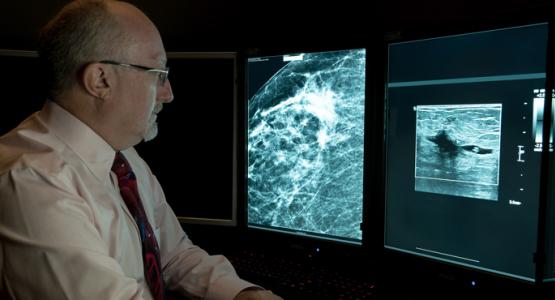
Tiny technology improves care for breast cancer surgery patients
Story by Elizabeth Long
Breast imaging technology has become more refined, allowing many breast abnormalities and cancers to be detected before they can be felt with a physical exam. While early detection allows for treatment to begin sooner and for patients to have better outcomes, it also presents a greater challenge in precisely locating and removing smaller or deeper masses.
A new approach
Previously, wire localization has been the only method to pinpoint certain breast lesions.
“Wire localization requires a wire to be placed near the mass immediately prior to surgery and the patient has to be transported to the operating room with the wire protruding from their breast,” says Kettering Physician Network breast surgeon Roxane Weighall, DO. “This can cause complications in scheduling as well as limited mobility and discomfort for some patients.”
Radioactive seed localization (RSL) is a new approach offering a unique set of benefits. Kettering Adventist HealthCare is the first in the Dayton area to offer this technology.
In RSL a radiologist places a “seed” measuring 5 millimeters—or about the size of a grain of rice—near the abnormal mass one to five days prior to surgery. The seed has a titanium shell and contains a minimal amount of radioactive iodine, which does not pose a risk of exposure to others.
“The patient’s body acts as a natural shield to the low radioactivity emitted from the seed,” says diagnostic radiologist William Meyers, DO. "The placement of the localization seed is more convenient and comfortable for a patient. The patient also no longer needs to be transported with a protruding wire from the skin and its inherent risk of displacement. This makes it a safer and more accurate, comfortable, and convenient alternative to the traditional method."
Precise localization
“The iodine inside the seed can be detected by the gamma meter used during a lumpectomy,” says Kettering Physician Network general surgeon Carol Sawmiller, MD. “This results in extremely precise localization of abnormal tissue.”
The seed can be seen on ultrasound and is removed with the affected breast tissue. Once the seed is removed, radioactivity is no longer present in the patient.
Studies consistently show use of RSL as opposed to wire localization reduces the rate of having a positive margin, where cancer cells are found in tissue surrounding the cancer. “Fewer positive margins reduces the need to return to the operating room for a second excision,” says Dr. Sawmiller. “This is a great benefit to patients, as well as a step towards reducing overall cost for treatment.”
“The introduction of RSL is just another example of how we are continuously striving to improve patient care by providing our patients with the most advanced technologies and more options,” says Kettering Breast Evaluation Centers Manager Susan Brake.

Add new comment